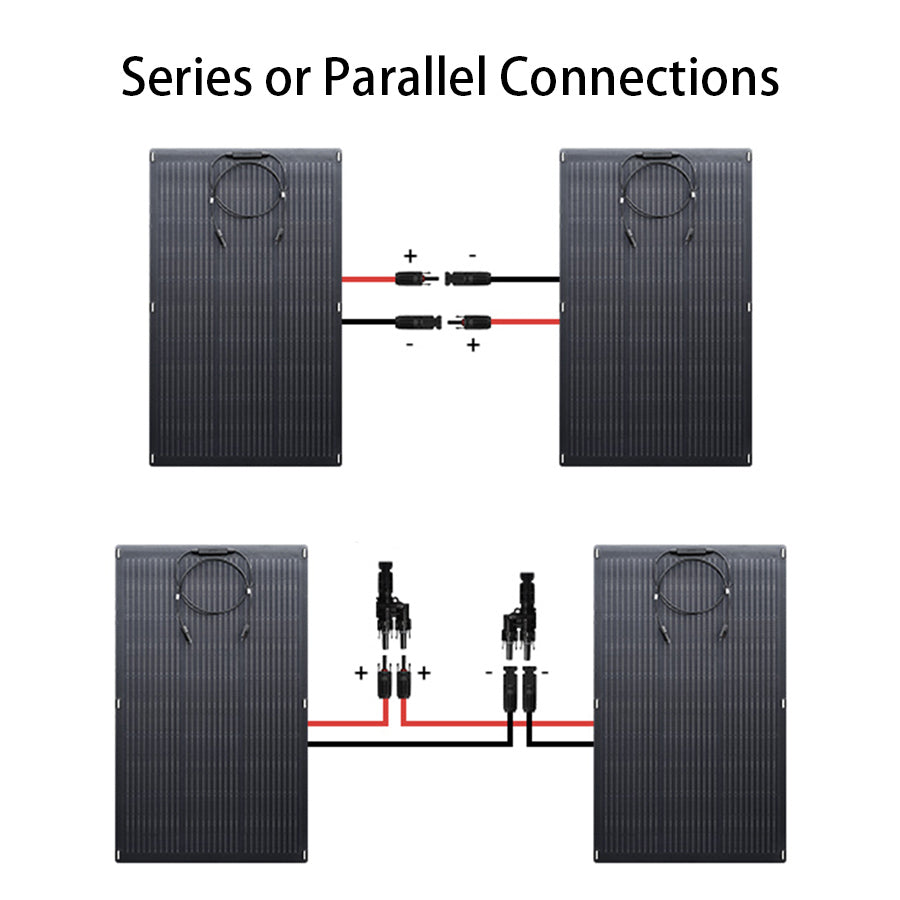Harnessing solar power is an effective way to generate renewable energy. Connecting multiple solar panels, either in series or parallel, can greatly increase the efficiency and adaptability of a solar energy system.
Series connections are advantageous when a higher voltage is required as they add the voltage of each panel while the current remains the same. This is ideal for systems that require a high input voltage. On the other hand, parallel connections are advantageous when a higher current is required.
In a parallel connection, the current from each panel sums while the voltage remains constant, ideal for systems with high input current requirements. Both methods have different advantages and are tailored to different energy needs to maximize the use of the solar panels.
Example: Connecting the ALLPOWERS R1500 Power Station with SF200 solar panels
Let's discuss the optimization of ALLPOWERS R1500 Power Station, which supports solar input of 12-60V and maximum current of 13A.
The SF200 panels have the following specifications:
- Open circuit voltage: 38.4V
- Short circuit current: 6.87A
- Maximum power voltage: 32V
- Maximum power current: 6.25A
A. Determining the connection type
The choice between series and parallel connection depends on the input requirements of the power station and the specifications of the panel.
- **Series connection**: Connecting two SF200 panels in series would result in a voltage of 64V, which exceeds the 60V limit of the R1500. Therefore, a series connection is not suitable in this case.
- **Parallel connection**: Connecting the panels in parallel is optimal. Two panels would produce a combined current of 12.5A, which is within the 13A limit of the R1500, and maintain a voltage of 32V, which is well within the 12-60V range.
B. Maximum panel connection and required accessories
Maximum Panels in Parallel: You can connect up to two SF200 panels in parallel without exceeding the voltage and current specifications of the R1500.
- Cables and connectors: For parallel connections, use MC4 Y-connectors to connect the panels. Make sure the cables are rated at least 15A to safely handle the combined current.
C. Precautions during connection
1. Safety first: Always turn off the power station and make sure the panels are not exposed to direct sunlight while connected.
2. Steps of parallel connection:
Connect the positive terminals of both SF200 panels with an MC4 Y-connector and repeat the same for the negative terminals.
Connect the combined positive and negative wires to the solar input of the R1500.
3. Check and test: Once the connection is made, expose the panels to sunlight and monitor the R1500 to ensure that the input is within the specified range.
By understanding the benefits of series and parallel connections and considering the specific needs of your solar panels and power station, you can optimize your solar energy setup. With the right connection strategy, the ALLPOWERS R1500 and SF200 panels can work efficiently together to provide a robust and adaptable renewable energy solution.
Series connections are advantageous when a higher voltage is required as they add the voltage of each panel while the current remains the same. This is ideal for systems that require a high input voltage. On the other hand, parallel connections are advantageous when a higher current is required.
In a parallel connection, the current from each panel sums while the voltage remains constant, ideal for systems with high input current requirements. Both methods have different advantages and are tailored to different energy needs to maximize the use of the solar panels.
Example: Connecting the ALLPOWERS R1500 Power Station with SF200 solar panels
Let's discuss the optimization of ALLPOWERS R1500 Power Station, which supports solar input of 12-60V and maximum current of 13A.
The SF200 panels have the following specifications:
- Open circuit voltage: 38.4V
- Short circuit current: 6.87A
- Maximum power voltage: 32V
- Maximum power current: 6.25A
A. Determining the connection type
The choice between series and parallel connection depends on the input requirements of the power station and the specifications of the panel.
- **Series connection**: Connecting two SF200 panels in series would result in a voltage of 64V, which exceeds the 60V limit of the R1500. Therefore, a series connection is not suitable in this case.
- **Parallel connection**: Connecting the panels in parallel is optimal. Two panels would produce a combined current of 12.5A, which is within the 13A limit of the R1500, and maintain a voltage of 32V, which is well within the 12-60V range.
B. Maximum panel connection and required accessories
Maximum Panels in Parallel: You can connect up to two SF200 panels in parallel without exceeding the voltage and current specifications of the R1500.
- Cables and connectors: For parallel connections, use MC4 Y-connectors to connect the panels. Make sure the cables are rated at least 15A to safely handle the combined current.
C. Precautions during connection
1. Safety first: Always turn off the power station and make sure the panels are not exposed to direct sunlight while connected.
2. Steps of parallel connection:
Connect the positive terminals of both SF200 panels with an MC4 Y-connector and repeat the same for the negative terminals.
Connect the combined positive and negative wires to the solar input of the R1500.
3. Check and test: Once the connection is made, expose the panels to sunlight and monitor the R1500 to ensure that the input is within the specified range.
By understanding the benefits of series and parallel connections and considering the specific needs of your solar panels and power station, you can optimize your solar energy setup. With the right connection strategy, the ALLPOWERS R1500 and SF200 panels can work efficiently together to provide a robust and adaptable renewable energy solution.
